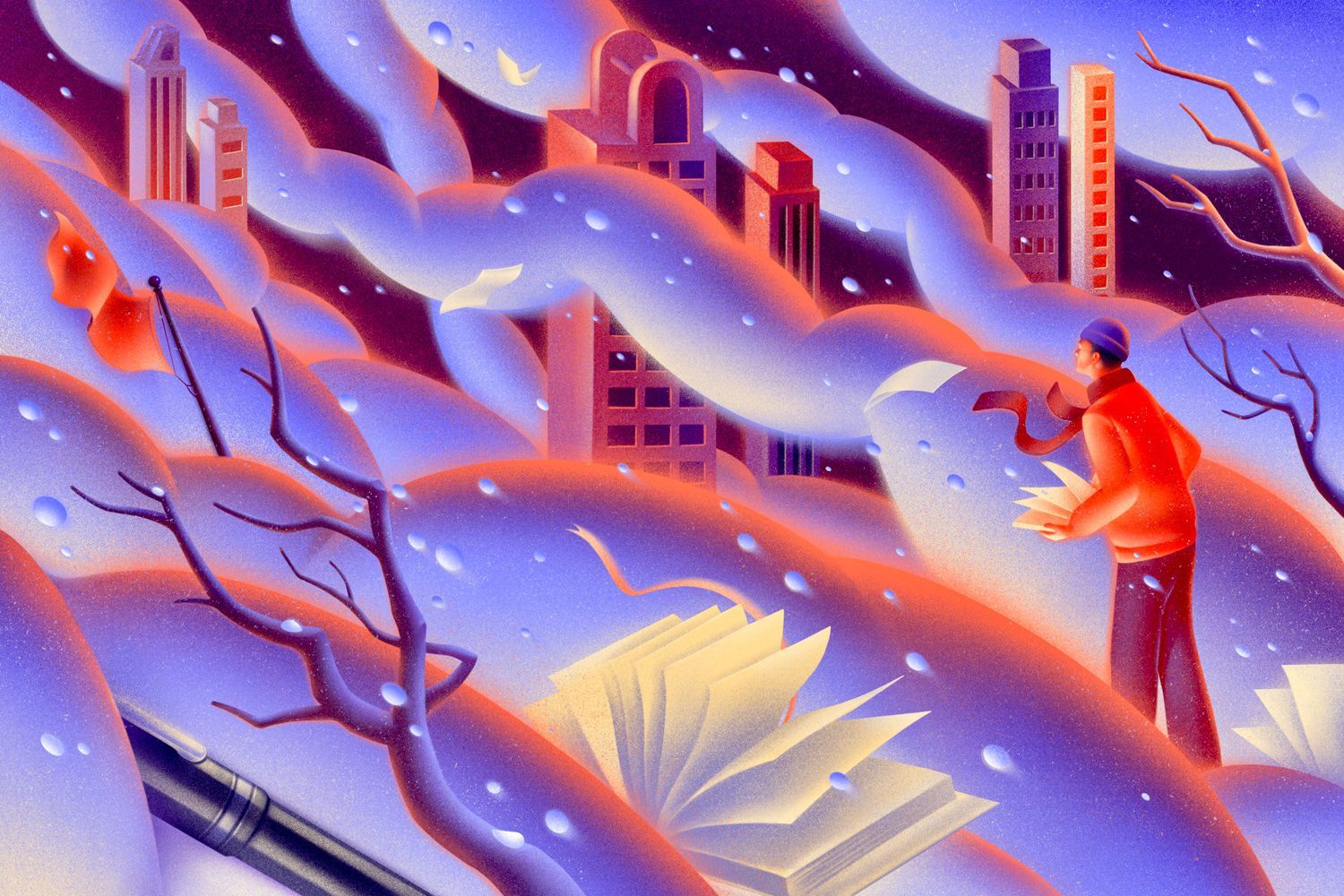The climate is changing. Science fiction is too.
The climate crisis has sparked its own literary genre. Is it just morbid entertainment, or could ‘cli-fi’ actually help us avert disaster?

Illustration by Wenjing Yang
In 2003, environmental activist Bill McKibben penned an essay for Granta bemoaning what he saw as a dearth of art about climate change. “Global warming has still to produce an Orwell or a Huxley,” he wrote, “a Verne or a Wells, a Nineteen Eighty-Four or a War of the Worlds.” The relative invisibility of climate change in popular culture, he concluded, was indicative of the public’s imagination of global warming overall: woefully marginal; minimised by the combined forces of apathy and ignorance.
Within a few years, McKibben would be, perhaps, relieved by a development in literature: the emergence of climate fiction, or “cli-fi”, a neologism coined by writer Dan Bloom in 2008. Despite the genre’s nominal similarity to sci-fi—another literary genre that often imagines dystopian futures—Bloom and cli-fi’s other, later advocates insist that the genre need not be the home of space colonies and inter-dimensional warfare. Rather, the title encapsulates all works of fiction that reckon with climate change, meaning that books with themes of natural disasters and resource depletion can fall neatly between genres: noir, thriller, speculative fiction, rom-com, YA, and social satire, to name a few.
While some authors who write cli-fi are adamant their fiction is nothing other than realism, it’s undeniable that climate fiction is a genre unto itself. Also undeniable? A lot of cli-fi—with its themes of warfare, refugee crises, pandemics, corporate greed, government futility and mass extinction—is a huge bummer. Some writers, like Briohny Doyle (who has written two works of cli-fi, The Island Will Sink and Echolalia), acknowledged in an interview over Zoom that “we're not necessarily going to climate fiction just for the pleasure of the text”. Which poses a few questions: What is cli-fi for? Does it exist, as McKibben may have wanted, primarily to promote awareness about climate change, or is it also an artistically rich literary genre? And if cli-fi is primarily a tool for activism, is it an effective one?
Humans have long used storytelling to critique human (mis)behaviour. The Genesis flood, Poseidon’s hurricanes, the sinking of Atlantis—our early parables drew a straight line between human actions and natural disasters. Millennia later, new economic models and social structures prompted tragic morality tales like (the highly problematic but anti-slavery) Uncle Tom’s Cabin, Oliver Twist and The Jungle, which used fiction to critique poverty, working conditions, and class inequality.
As technology continued to advance in the 20th century, science fiction offered—as cli-fi author Kim Stanley Robinson described to the New Yorker—something like 3-D glasses for its readership. “Through one lens, sci-fi offers predictions about the future… through the other, we see metaphors for our own time.” The most successful sci-fi authors offered us a lasting language to characterise political plight: “Orwellian” is now a common synonym for authoritarian government, surveillance, war, propaganda and dystopia. Similarly, Margaret Atwood’s The Handmaid’s Tale is often referenced as a metaphor for patriarchal violence, the oppression of women, white supremacy and control over women’s bodies.
Could cli-fi be the political movement of the 21st century? Bill McKibben and Amitav Ghosh certainly think so. But while cli-fi hasn’t yet reached the literary mainstream (only Cormac McCarthy’s The Road, itself only tangentially concerned with climate change, has found something like a general audience), it has managed to attract a dedicated audience of fans drawn in by its familiar topes and tensions. In books such as Odds Against Tomorrow, The Maddaddam Trilogy, War Girls, and The Collapse of Western Civilization: A View from the Future, writers evoke everything from apocalypse, plagues, war and new empires to offer prophecies of looming natural destruction. Familiar ground, perhaps, though unlike the legends of yore, where vengeance is wrought by a wrathful god, in cli-fi, humans are both victim and cause. And just like Cassandra, fated by the Greek gods to deliver prophecies no one believes, cli-fi authors may well wonder if anyone is listening.
With storylines of forest fires, hurricanes and depleted resources held against the backdrop of toothless governments and greedy corporations, cli-fi has been accused by some critics of being unsubtle in its attempts to get the reader to think outside the fictional world of the novel and inside the real one we actually live in. Worse, it has been labelled ‘educational’, a potentially fatal charge for any artistic work.
Even the most effective cli-fi struggles against the same problem facing the climate movement: paralysis.
Which isn’t to say that these texts are bad. Omar El Akkad’s American War, for example, is beautifully, emotionally written, captivating, rich—and painfully bleak. The book imagines the United States in 50 years’ time, following a poor family in the American South during the Second Civil War: a conflict sparked by the South’s refusal to stop using fossil fuels. The environment is only rarely mentioned directly, but the dissolution of society as we know it is its implicit result.
For authors working in cli-fi, writing is a delicate balance between artmaking, entertainment and messaging. Briohny Doyle, for example, didn’t set out to write climate fiction with her 2013 novel The Island Will Sink, a dystopia in which two of the book’s main characters set out to document an island before it is swallowed by the rising sea. Island “started with a setting,” Doyle explained. “A ‘what if’ sort of scenario. And it addressed climate change because when I thought of the near future, that’s what I thought of.”
For Margaret Atwood, engaging the reader comes first and foremost, well above activism. “The only rule is this,” she told The Huffington Post in 2014. “You shall make it so that the reader keeps turning the page. Otherwise your wonderful message you put on page 232—they’ll never get there.”
With Island, Doyle explained, she wanted to “say something”—a goal, she quickly acknowledged, is inherently “political, but it’s certainly not political like activism is political”. Writing books that commented on climate change wasn’t quite “activism,” Doyle explained—at least, not to her. “If anything, [it’s] more akin to criticism.”
In 2018, Professor Matthew Schneider-Mayerson polled 161 American volunteers who had read any of 19 listed works of cli-fi, including Barbara Kingsolver’s Flight Behavior, Paolo Bacigalupi’s The Windup Girl, T.C. Boyle’s A Friend of The Earth and Matthew Glass’s Ultimatum. His aim was two-fold: to find out who was reading climate fiction, and then to measure its impact. How did readers feel after engaging with these stories? Were they inspired to make a difference? If so, how?
Perhaps unsurprisingly, Schneider-Mayerson found that “the majority of emotional responses [to reading cli-fi] were dramatically negative”; they were “intense, immediate, and self-directed”. Readers used words like “helpless,” “incredibly sad,” “guilty,” “depressed,” and “sad and disheartened” to describe themselves. Overall, the study noted, they tended to be “younger, more liberal, and more concerned about climate change than nonreaders of climate fiction”.
Schneider-Mayerson’s conclusions were nuanced. “Numerous readers” in this generally liberal, young cohort “drew a direct connection between their reading experiences and subsequent actions.” These respondents discussed the books with their families and peers, which then frequently led to exchanges about climate change. Other readers reported “shopping differently,” “driving or flying less,” and “using recyclable shopping bags”. However, the academic wrote, affected readers “did not start ‘voting on a candidate’s stance on this issue’ or ‘participating in activist or protest movements around this issue’”.
As such, even the most effective cli-fi struggles against the same problem facing the climate movement: paralysis. Existential fear, however legitimate, can cause people to despair. How much can a single person do? Why aren’t the more powerful doing more? What does it take to make a change? Could such change even be possible? And then, a distressing alchemy: despair transforms into a more comfortable apathy. Why do anything when nothing seems possible?
If cli-fi has a credo, it’s Frederic Jameson’s mournful adage that “it is easier to imagine the end of the world than to imagine the end of capitalism”. It is then, perhaps, unsurprising that Jameson’s own former student, Kim Stanley Robinson, has built a career as one of cli-fi’s few— if not only—self-described “utopian” writers. Writing on his oeuvre for The Nation, Robinson explained the activist value of a hopeful political imagination:
Utopias are thought experiments. Imagine if things ran like this: Wouldn’t that be good? Well, maybe… let’s live in it fictionally for a while. What problems crop up in this system? Can we solve them?
For Robinson, utopia is not akin to paradise. Rather, it’s “an idealized society” where “everything works well—maybe even perfectly, but for sure better than things work now”. In order to get the narrative tension necessary for a novel, he continues, you can have the conflicts of a traditional novel, worked out in the idealised society of utopia.
Robinson’s latest novel, The Ministry for the Future (2020), opens with an unimaginable environmental crisis in India. Shell-shocked and sweating, its sole survivor continues to re-live the moments when “everyone died”. Government agencies and scientists are routinely stymied by their own impotence; violent bands of anarchists rise up; corporations remain all-powerful. And still, in the scorched earth of climate fiction and the fumbling ‘utopia’ of Ministry, Robinson is the only author who managed to offer New Yorker contributor Joshua Rothman an iota of “hope about our collective future”. As such, Rothman’s profile of Robinson is glowing, nearly rapturous: the mythical Midwestern novelist who managed to describe the future and make it sound actually okay.
Today, our culture is rife with hopelessness. Summarising what ails us can read like its own cli-fi blurb: an endless pandemic, unpredictable international warfare, refugee crises, floods, fires, air pollution, duelling billionaires, commercial trips to the moon. As many cli-fi writers have emphasised, we need to encourage people to care about the climate crisis. Tales of scorched Earths and Waterworld-style dystopias have their appeal. But is devastating literature our only recourse? In both the climate movement and the worldbuilding of cli-fi, we need to be unafraid to nurture that most fragile feeling: hope. As Kim Stanley Robinson said in a 2009 interview, “Utopias are hard, and important, because we need to imagine what it might be like if we did things well enough to say to our kids, we did our best, this is about as good as it was when it was handed to us, take care of it and do better”.
